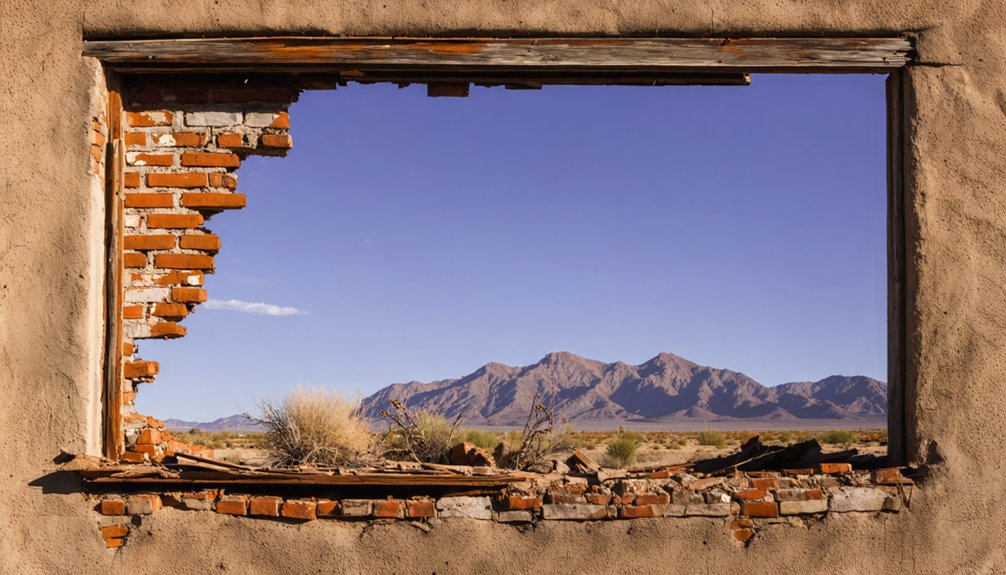You’ll find Toyah’s haunting remains along the Texas and Pacific Railway line, where this once-bustling West Texas town began as a trading post in 1879. At its peak in the 1920s, over 1,100 residents called Toyah home, with four churches, multiple stores, and two banks defining its landscape. Today, fewer than 100 people live among the weathered buildings and empty storefronts, while devastating floods and harsh winds have transformed this railroad hub into a stark reflection of boom-and-bust Texas history.
Key Takeaways
- Toyah transformed from a thriving railroad town of 1,100 residents in the 1920s to a ghost town with only 61 residents by 2020.
- A devastating flood in 2004 breached the town’s protective dike and damaged nearly every building, accelerating its decline.
- Historic structures like Toyah High School, W.W. Cole Building, and Hicks-Cobb store remain as deteriorating remnants of the town’s prosperous past.
- The Great Depression and subsequent decline of railroad operations led to mass exodus, with population dropping dramatically by the 1930s.
- Abandoned buildings, empty gas stations, and a forgotten post office characterize the current ghost town landscape of Toyah.
From Trading Post to Railroad Town: The Birth of Toyah
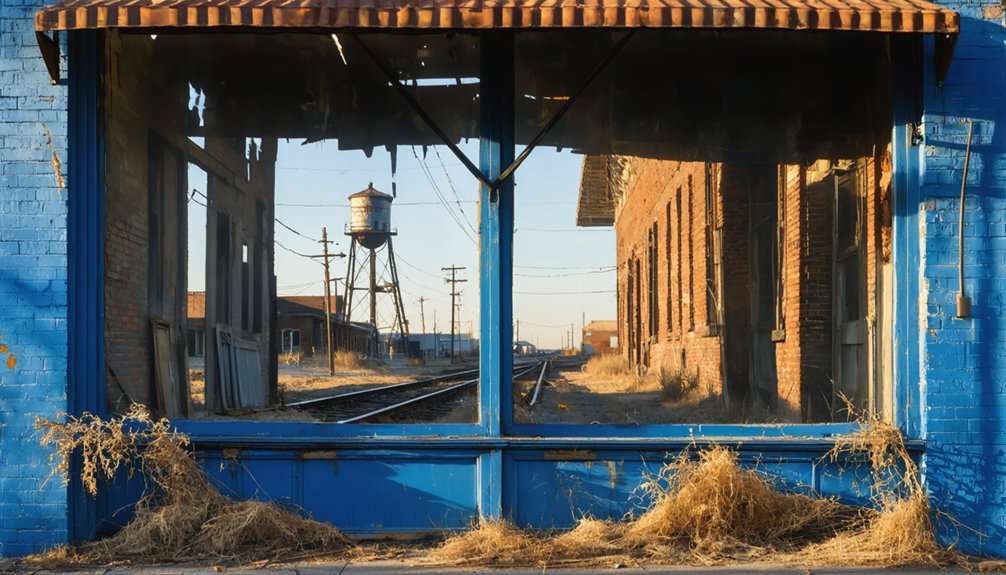
Nestled along Billingslea Draw in West Texas, Toyah emerged from humble beginnings as a trading post serving the vast ranching operations of Reeves County. In 1879, W.T. Youngblood and his family arrived by covered wagon, establishing a tent store that would become the heart of the fledgling community. The name “Toyah,” meaning “flowing water,” referenced the local artesian springs that drew settlers to this strategic location.
The trading post transformed dramatically in 1881 when the Texas and Pacific Railway chose Toyah as a construction section base. You’d have witnessed the rapid evolution from Youngblood’s one-room adobe store to a bustling railroad town complete with section houses, a roundhouse, and shops. By the end of that year, the town was flourishing with tents and saloons dotting the landscape.
The railway’s arrival sparked new growth, establishing Toyah as a crucial shipping hub for cattle and a key stop for the Overland Stage Company. A critical milestone came when the post office opened in 1881, allowing residents and ranchers to maintain vital connections with the outside world.
Glory Days: A Thriving West Texas Hub (1880-1914)
You’ll find Toyah’s most prosperous era unfolded between 1880 and 1914, as the railroad’s arrival transformed this former trading post into a bustling hub with over 1,000 residents.
The first train arrived in 1881, bringing unprecedented development to the area, with tents, saloons, and restaurants quickly springing up to serve the growing population. The town’s strategic location made it a major cattle-shipping center, attracting banks, hotels, saloons, and various businesses that served both locals and travelers.
Railroad commerce combined with the broader West Texas oil and cattle boom created unprecedented growth, with Toyah’s population reaching its peak of 1,100 during the prosperous years of 1914-1929. The town maintained a strong commercial presence with seventeen active businesses throughout the 1930s.
Railroad Brings Economic Boom
The arrival of the Texas and Pacific Railway in 1880 transformed Toyah from a modest settlement into a bustling West Texas transportation hub.
You’d have witnessed the railroad’s influence through the rapid construction of section houses, a roundhouse, and railway shops that created jobs and sparked economic growth.
A thriving stagecoach service began operations in 1882, transporting passengers and mail between Toyah and Brogado.
Population Growth Fuels Development
Following the railway’s arrival in 1880, Toyah experienced remarkable population growth that transformed it from a modest settlement into a vibrant West Texas community.
You’ll find that population dynamics shifted dramatically, with residents increasing from 600 in 1892 to over 1,000 by 1914. The town’s community resilience was evident in its rapid development of infrastructure, including four churches, multiple stores, and two banks.
By 1910, you could’ve walked down Toyah’s bustling streets lined with hotels, restaurants, and saloons. The construction of a large brick school in 1912 reflected the town’s commitment to education, with student enrollment expanding from 42 to 55 students in just two years. Historical disambiguation records indicate multiple variants of the town’s name during this period.
This growth sustained Toyah’s prosperity until the Great Depression’s onset in 1929.
Ranching Industry Drives Progress
While population growth spurred Toyah’s development, ranching formed the backbone of its economic prosperity from 1880 to 1914.
You’d have found W.T. Youngblood’s trading post serving as the heart of ranch commerce, where cattlemen gathered supplies before heading back to their spreads. The Texas and Pacific Railway’s arrival in 1881 transformed Toyah into a bustling cattle shipping hub, connecting local ranchers to lucrative markets beyond Texas. Like many ranching operations across the state during this period, local ranchers began transitioning from free grass grazing to purchasing their own pasture lands.
To combat cattle rustling, ranchers relied on cowboy-detectives like Charles Siringo to protect their interests.
The Swenson Land Company and Toyah Valley Live Stock Company developed extensive irrigation systems fed by artesian springs, cultivating 17,000 acres to support cattle operations. This infrastructure, combined with the railway’s presence, cemented Toyah’s position as a thriving ranching center.
The Railroad’s Impact on Growth and Commerce
When you visit Toyah’s old rail station site today, you’d find it hard to imagine the bustling commerce that erupted after the Texas and Pacific Railway’s arrival in 1881.
The station quickly became the region’s primary livestock shipping point, with cattle drives converging from ranches across West Texas to load onto eastbound trains.
The Texas and Pacific Railway’s rapid expansion added nearly 1,000 miles of track between 1873 and 1881, helping connect remote towns like Toyah to major commercial centers.
Construction efforts were remarkable, as crews worked through numerous challenges including low water levels and a devastating yellow fever epidemic.
Railroad Station Development
As the Texas and Pacific Railroad blazed through Reeves County in 1880, Toyah emerged as an important railroad stop that would transform the settlement’s destiny. This railroad innovation established Toyah as a division point, marking a significant step in the region’s transportation evolution. The Youngblood Hotel provided essential lodging for train crews passing through the town.
- A thorough roundhouse facility was built in 1881 to service and maintain locomotives.
- Section houses dotted the rail line, providing vital housing for maintenance crews.
- Railroad shops were constructed to support ongoing mechanical operations.
- The station complex included crew accommodations and operational facilities.
- The first train’s arrival in 1881 inaugurated regular service through the settlement.
Livestock Shipping Operations
Following the arrival of the Texas & Pacific Railroad in 1881, Toyah rapidly emerged as a major cattle-shipping hub for West Texas ranchers. The railroad transformed livestock transport by replacing slow wagon routes with efficient rail shipments, while new shipping infrastructure included stockyards and maintenance facilities to handle the increasing flow of cattle.
You’d have found a bustling town driven by livestock commerce, with hotels and merchants serving both ranchers and railroad workers. The area’s prominence even attracted legendary cowboy-detective Charles Siringo, who fought cattle rustling in 1882.
While Toyah reached its peak population by 1910, changes in regional shipping patterns eventually shifted operations south to Toyahvale. This change, combined with broader economic challenges of the Great Depression, led to Toyah’s decline as a livestock shipping center.
Economic Transformation Timeline
The Texas & Pacific Railroad‘s arrival in 1881 sparked Toyah’s dramatic transformation from a modest trading post into a vibrant commercial hub.
You’ll find that Toyah’s economic infrastructure evolved rapidly as the railroad enabled robust commerce and regional trade. By 1914, you’d have seen a thriving town of over 1,000 residents, with community resilience evident in its growing business district and cattle-shipping operations.
- Overland Stage Company launched six weekly routes in 1881, connecting Toyah to Fort Davis and Fort Stockton
- Railroad facilities expanded to include section houses, a roundhouse, and maintenance shops
- Local businesses progressed from adobe structures to permanent brick buildings
- A new brick schoolhouse in 1912 reflected the town’s prosperity
The Great Depression triggered decline, reducing population to 553 by 1931.
Notable Characters and Historical Events
While many frontier towns faded into obscurity, Toyah’s notable characters and historical events paint a vivid picture of life in early Texas.
You’ll find pioneering spirits like W.T. Youngblood, who arrived by covered wagon in 1879 and established the town’s first adobe store. The legendary Charles Siringo hunted cattle rustlers here in 1882, bringing law to the wild frontier.
Amelia Earhart’s unexpected five-day visit in 1928 brought excitement to local youth who gathered around her aircraft.
But Toyah’s history also reveals darker moments, particularly the racial violence of 1906 when J.I. “Slab” Pitts was lynched for his relationship with a white woman.
These historical figures, from merchants to aviators, shaped Toyah’s transformation from a bustling railroad hub to today’s ghost town.
Life in Early Toyah: Schools, Hotels, and Stagecoaches
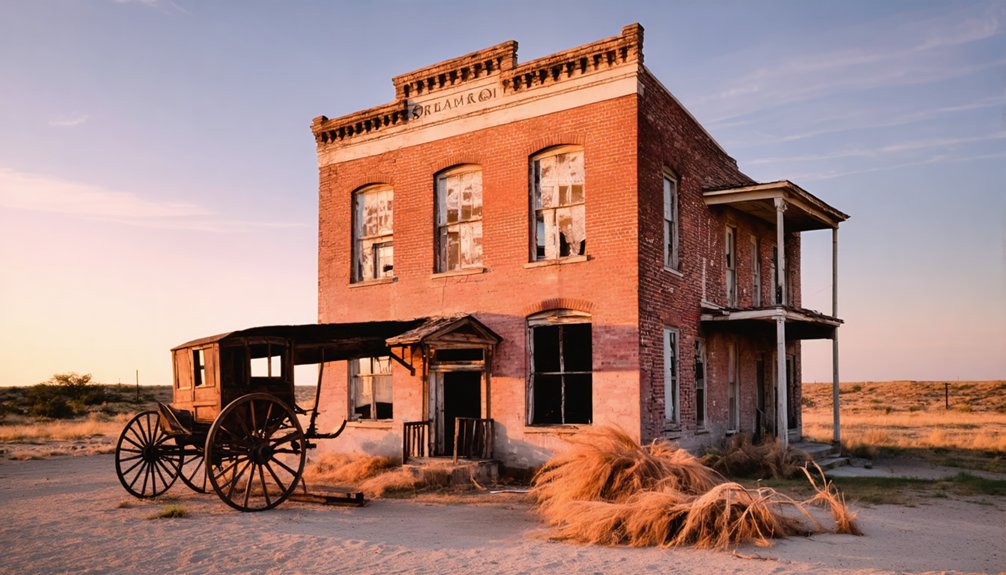
If you’d visited Toyah in its early heyday, you’d have found a bustling brick schoolhouse built in 1912, where both elementary and high school students received their education until declining enrollment forced its closure.
You could’ve stayed at one of two hotels catering to railroad workers, ranchers, and traveling salesmen when the town’s population topped 1,000 residents.
The Overland Stage Company’s six weekly runs connected you to Fort Davis and Fort Stockton, establishing crucial transportation links before and alongside the Texas & Pacific Railroad‘s arrival in the 1880s.
Growing Educational Legacy
During Toyah’s peak years around 1910, education played a central role in shaping the town’s identity, anchored by the imposing brick schoolhouse built in 1912.
The school’s educational significance extended far beyond basic instruction, serving as a crucial hub for community engagement during the town’s railroad and ranching heyday.
You’ll find that even as Toyah’s population declined from 1,052 to 553 during the Great Depression, the school persisted as a symbol of the community’s resilience.
- The brick schoolhouse served both elementary and high school students
- School grounds hosted community gatherings and social events
- Multiple weekly stagecoach routes connected students from outlying areas
- Local ranching and railroad families supported the school’s development
- The building stands today as a monument to Toyah’s educational heritage
Historic Hotels Serve Travelers
As travelers stepped off the Texas and Pacific Railway in 1881, Toyah’s emerging hotel industry quickly became the backbone of the town’s hospitality sector.
The A.M. Fields Hotel, opening in 1886, set the standard for frontier-style hotel architecture that would shape the town’s character. You’d find these establishments bustling with cowboys, ranchers, and merchants, serving as essential social hubs where transient communities connected.
With six daily stagecoach routes linking to Fort Stockton and Fort Davis, these hotels weren’t just places to rest – they were catalysts for commerce. They employed locals, supported neighboring businesses, and helped establish Toyah as a regional transportation hub.
The hotels’ prominence lasted through the 1920s, when the town peaked at over 1,000 residents, before declining alongside Toyah’s fortunes during the Great Depression.
Stagecoach Routes Link Forts
The Overland Stage Company transformed Toyah’s frontier landscape in 1881, launching six weekly stagecoach routes that connected the newly established railroad town to Fort Davis and Fort Stockton.
You’d find the stagecoach logistics well-coordinated with the railroad’s arrival, creating an essential frontier transportation network that turned Toyah from a tent settlement into a bustling hub.
- Coaches carried up to 15 passengers – 6 inside, 9 on top
- Stagecoach depot served as a transfer point between rail and remote destinations
- Routes supported law enforcement efforts against cattle rustlers
- Regular service encouraged ranching and cattle shipping businesses
- Stagecoach lines operated between railroad heads, extending travel westward into unsettled territories
The stage service helped establish Toyah as a key commercial center, linking isolated ranches and military outposts across the Texas frontier.
The Great Depression’s Devastating Effect
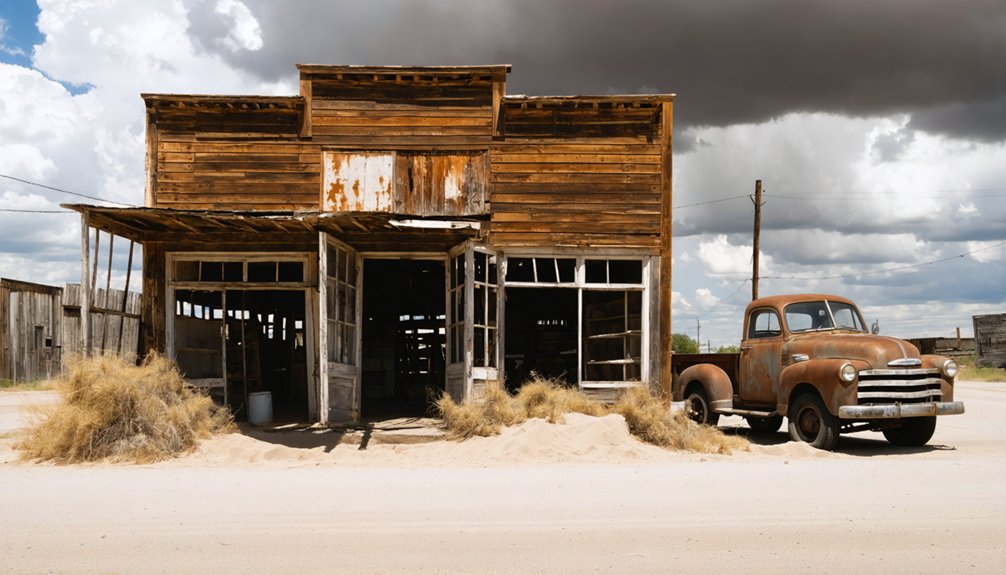
While many Texas towns struggled through the Great Depression, few faced devastation as complete as Toyah’s economic collapse after 1929.
You’ll find the town’s population plummeted from 1,100 to just 553 by 1931, as economic hardships forced residents to seek opportunities elsewhere. Local businesses vanished rapidly, with only 17 remaining where banks, hotels, and stores once thrived.
The community disintegration hit hard as farmers faced foreclosures and devastating crop losses. You can trace Toyah’s decline through shuttered churches, abandoned schools, and empty storefronts.
The town’s essential cattle-shipping industry withered as nearby communities captured the business. By the 1960s, population had dwindled to 280, leaving behind empty buildings as silent witnesses to the Depression’s crushing impact on this once-prosperous West Texas town.
Natural Disasters and Physical Decline
Devastating natural disasters struck repeated blows to Toyah’s already fragile existence after its economic decline.
You’ll find the town’s protective dike breached in 2004 when eight inches of rain fell in just two hours, flooding nearly every building. The flood impacts, combined with harsh West Texas winds and storms, accelerated infrastructure decay throughout the settlement.
A devastating flood breached Toyah’s dike in 2004, while relentless West Texas storms hastened the town’s deterioration.
Abandoned oil and gas wells nearby created additional hazards, including a 2024 blowout that released dangerous chemicals and fumes.
- Floodwaters destroyed or damaged most historic buildings
- High winds and sandstorms eroded remaining structures
- Weather cycles weakened foundations and roofs, leading to collapses
- Orphaned wells pose ongoing environmental threats
- Schools, banks, and stores closed as buildings crumbled and people fled
Springs, Plains, and Geographic Significance
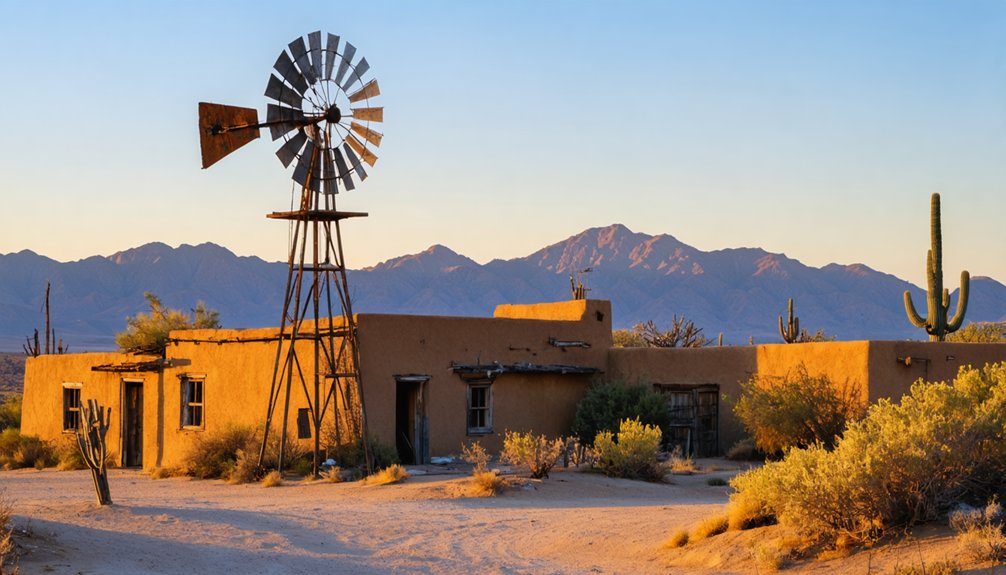
Situated at an elevation of 888 meters in Texas’s Chihuahuan Desert plains, Toyah’s geographic setting played a crucial role in both its rise and eventual decline.
You’ll find this former trading post at 31.3133° N and -103.7930° W, where the flat terrain made it ideal for early stagecoach routes and railroad development.
The springs significance in this arid region can’t be understated – with no major natural springs within the townsite, settlers relied heavily on wells and distant water sources.
The plains ecology reflects typical Chihuahuan Desert characteristics, featuring sandy soils and sparse vegetation that supported ranching operations.
While these geographic features initially helped establish Toyah as a transportation hub, they ultimately contributed to its ghost town status, as limited water resources and environmental isolation restricted long-term growth.
Preserving the Memory: Photography and Research
Modern photographers and historians have worked diligently to document Toyah’s ghostly remnants, capturing the stark beauty of its abandoned structures against the Chihuahuan Desert backdrop.
Through photographic storytelling and historical preservation efforts, you’ll discover how this once-bustling railroad town’s memory lives on in both digital and physical archives.
Photographs and archives breathe life into Toyah’s past, preserving memories of a thriving railroad community now lost to time.
- Black-and-white photographs showcase the haunting 1912 brick schoolhouse, now slowly crumbling
- Drone imagery reveals the skeletal remains of Toyah’s original street grid from above
- Historical collections like The Toyah Taproots preserve stories of the town’s heyday
- Digital documentation efforts protect the site’s heritage despite limited preservation funds
- Researchers track Toyah’s decline through census data, showing just 61 residents as of 2020
What Remains: A Tour Through Modern Toyah
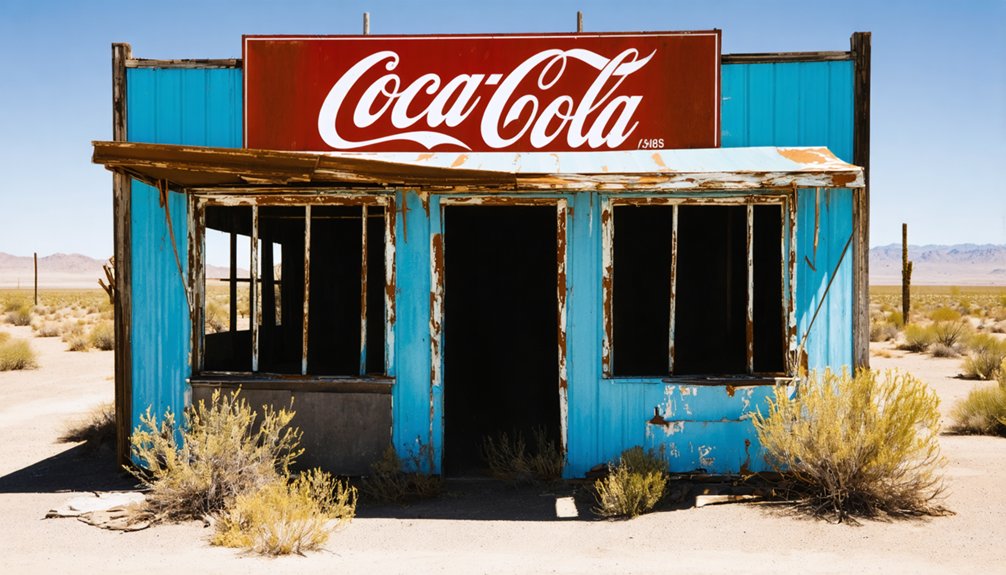
As you venture into present-day Toyah, the haunting remnants of this once-thriving railroad town emerge from the Chihuahuan Desert landscape.
You’ll find the imposing Toyah High School building, where ghostly legends still echo through empty halls, alongside the historic W.W. Cole Building and Hicks-Cobb store. These structures stand as silent sentinels of abandoned beauty amid 1.6 square miles of weathered streets.
The 2004 floods dealt a devastating blow, leaving most buildings in decay.
Now, fewer than 100 residents call this remote outpost home. Empty gas stations, a forgotten post office, and deteriorating homes dot the landscape.
Despite harsh desert conditions and relentless storms taking their toll, Toyah’s remaining structures continue to captivate visitors with their haunting allure and rich historical significance.
Frequently Asked Questions
What Happened to the Original W.T. Youngblood Store Building?
You’ll find that Youngblood’s original adobe store has vanished from history, with no restoration attempts made. The site’s only marker today is the newer Toyah Trading Post building.
Are There Any Surviving Descendants of Original Toyah Families Still Living There?
Time washes away all traces – you won’t find descendant interviews or family history confirming any original families still there today. Census data shows mostly new residents among the remaining 61 people.
What Was the Average Property Value in Toyah During Its Peak?
You’d find exact average property values weren’t documented, but given Toyah’s economic decline after 1929, peak values likely occurred during 1910-1914 when the town’s population and commercial activity reached their height.
Did Any Famous Western Movies Ever Film Scenes in Toyah?
You’ll find Toyah’s Western film connections center primarily on Kevin Costner’s cult classic “Fandango” from 1985. The movie used several local buildings, but Toyah’s movie history doesn’t include other notable Western productions.
How Did Residents Get Their Drinking Water in Early Toyah?
You’d get your drinking water hauled in by barrel from Monahans, since early Toyah lacked local drinking sources. Water conservation was vital, with every precious drop carefully rationed until infrastructure developed.
References
- https://www.legendsofamerica.com/toyah-texas/
- https://beyond.nvexpeditions.com/texas/toyah.php
- https://en.wikipedia.org/wiki/Toyah
- https://mansfieldphoto.com/small-towns-of-texas/toyah-texas-ghost-town/
- https://theforgottensouth.com/toyah-texas-ghost-town/
- https://www.youtube.com/watch?v=-_ykJkZG160
- https://www.texasescapes.com/TOWNS/Toyah_Texas/Toyah_Texas.htm
- https://www.youtube.com/watch?v=2lpZOI62WOw
- http://freepages.rootsweb.com/~gtusa/history/usa/tx/toyah.htm
- https://www.tshaonline.org/handbook/entries/toyah-tx
